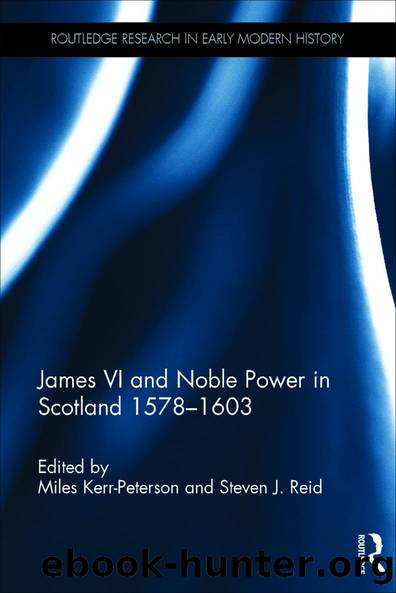James VI and Noble Power in Scotland 1578 - 1603 by Miles Kerr-Peterson & Steven J. Reid

Author:Miles Kerr-Peterson & Steven J. Reid [Kerr-Peterson, Miles & Reid, Steven J.]
Language: eng
Format: epub
ISBN: 9781138946064
Goodreads: 26537833
Publisher: Routledge
Published: 2016-09-08T00:00:00+00:00
III
It is against this background of personal rivalry and recurrent violence that we need to see the altercations between young Walter Scott of Buccleuch (born sometime around 1567) and the Cessford heir, young Robert. Both menâs actions were informed by the circumstances and collective memories of previous events and the reiteration of these during attempts to resolve the Scott-Ker feud. At the same time, the historical competition between the Scotts and Kers for local office was played out again between the current leaders in their own version of a feud that had been socially structured by their kindreds.
As the new leader of the Scott kindred by the mid-1580s, Buccleuchâs challenge to Ker power in the region recalled previous rivalries that had ended badly. This was at a time when William Ker of Cessford was getting older; his headstrong son Robert Ker was a few years younger than Buccleuch; Cessford would not be ready until the early 1590s to hand over to Robert his leadership of the Kers and the Middle March wardenship. The signs for future peace were not good, with both men reputed to be combative. Robert Ker was said to be âambitious, proude, bloody in revenge, poore and easylie framed to anie purpose in courte or countryâ, whilst Buccleuch was described variously as âproude, malitious, mimitating the Spaniardâ, and as âa man of energy, prompt in counsel and action, powerful in fortune, force, arms and followingâ.40 The intense personal rivalry that developed between these two feisty men, both with access to significant manpower and resources in the Middle March, was to continue to stoke the collective memories of the enmity between their surnames. Attempting to settle the disputes of the past, and perhaps anticipating future trouble, Robert Kerâs sister, Margaret, was married to Buccleuch in 1586 in order to encourage warmer relations between the two families. Margaret was subsequently described by her sister as âa good Ker, if ever there wasâ, which must have made life interesting, ensconced as she was in a Scott household.41
However, dispute between such rivals, vying for dominance in the Middle March, was perhaps inevitable â even without such a long tradition of antagonism between their families. Additionally, as ever, court politics were to impact again in the early 1590s, when Buccleuchâs deluded stepfather, Francis Stewart, Earl of Bothwell, rebelled against his cousin James VI. Buccleuch was initially forced into temporary exile for his complicity in Bothwellâs raids, but Jamesâ recognition that he needed the cooperation of the major landholders in the Borders in maintaining order meant that Buccleuch was able to return by 1594.42 Buccleuch and Cessfordâs personal rivalry was seen in their competition for the keepership of Liddesdale, which Bothwell had held, and which Cessford had managed to get his hands on briefly between November 1591 and June 1592. In 1594, both profited hugely from the forfeiture of Bothwell, with Buccleuch winning the lordship of Liddesdale and the permanent grant of the keepership, much to the irritation of Cessford. This meant that
Download
This site does not store any files on its server. We only index and link to content provided by other sites. Please contact the content providers to delete copyright contents if any and email us, we'll remove relevant links or contents immediately.
| General | Channel Islands |
| England | Northern Ireland |
| Scotland | Wales |
Room 212 by Kate Stewart(5014)
The Crown by Robert Lacey(4710)
Endurance: Shackleton's Incredible Voyage by Alfred Lansing(4655)
The Iron Duke by The Iron Duke(4274)
The Rape of Nanking by Iris Chang(4124)
Joan of Arc by Mary Gordon(4000)
Killing England by Bill O'Reilly(3937)
Say Nothing by Patrick Radden Keefe(3891)
I'll Give You the Sun by Jandy Nelson(3343)
Shadow of Night by Deborah Harkness(3278)
Hitler's Monsters by Eric Kurlander(3256)
Mary, Queen of Scots, and the Murder of Lord Darnley by Alison Weir(3135)
Blood and Sand by Alex Von Tunzelmann(3121)
Darkest Hour by Anthony McCarten(3058)
Eleanor & Park by Rainbow Rowell(3040)
Margaret Thatcher: The Autobiography by Thatcher Margaret(3021)
Red Famine: Stalin's War on Ukraine by Anne Applebaum(2857)
Book of Life by Deborah Harkness(2854)
The One Memory of Flora Banks by Emily Barr(2789)
